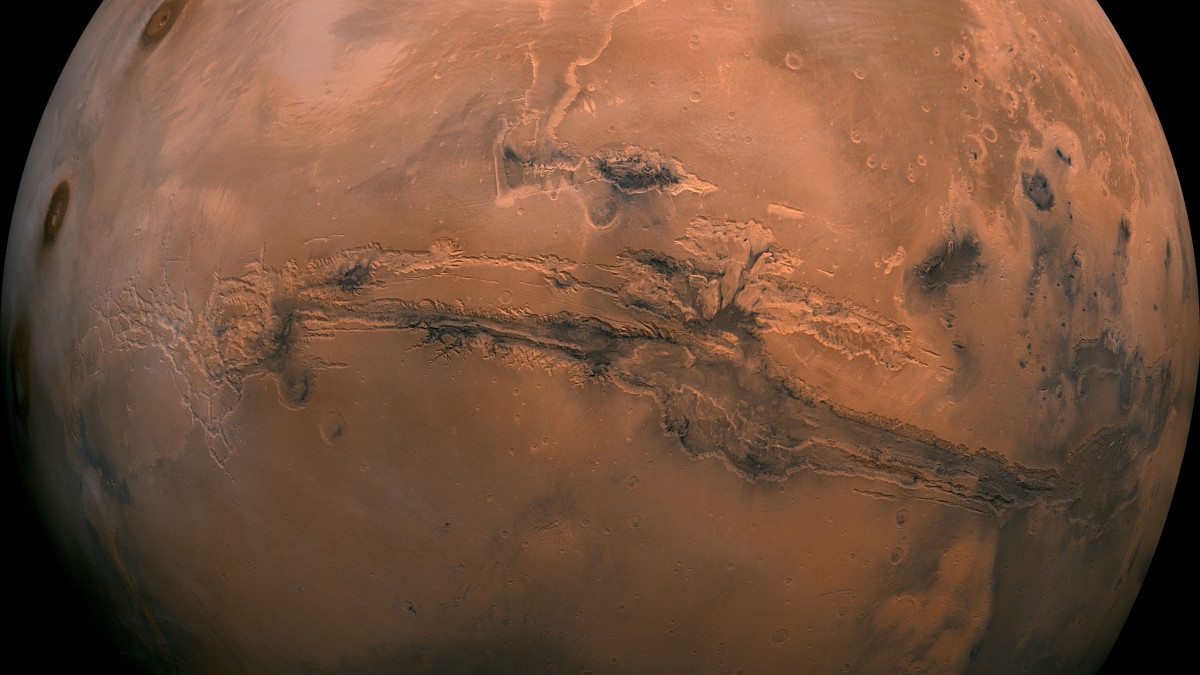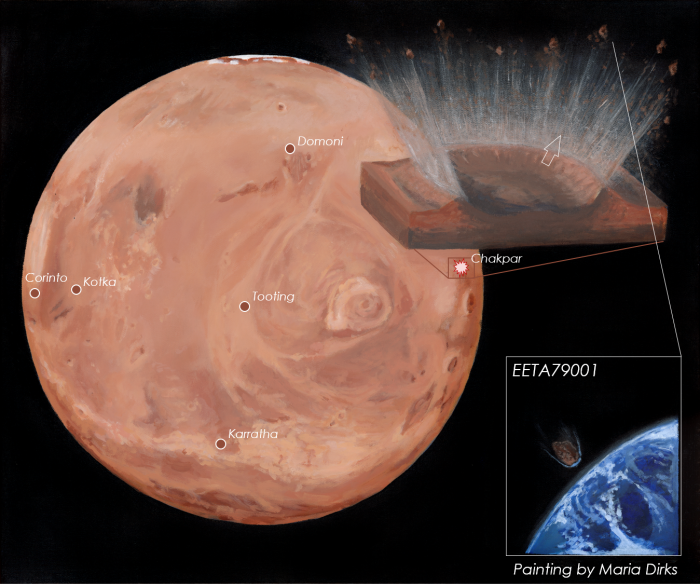Mapping the red planet's geologic timeline through impact craters

Mosaic of the Valles Marineris hemisphere of Mars projected into point perspective, a view similar to that which one would see from a spacecraft. Photo courtesy of NASA
Roughly 140 million miles. That's the distance traveled by chunks of the Red Planet by the time they reach Earth.
But exactly where on Mars those chunks came from was a mystery. Until now.
A team of scientists, including Arizona State University's Tom Sharp, have determined specific locations on Mars from which most of the approximately 200 Martian meteorites originate, tracing them back to five impact craters within two volcanic regions known as Tharsis and Elysium.
Their findings were recently published in the journal Science Advances.
This study marks a significant advancement in solving the mysteries of Mars, as previous efforts to detect the precise sources of Martian meteorites had been largely unsuccessful. With this breakthrough, researchers can now categorize these meteorites based on their shared history and their original locations on the Martian surface.
Martian meteorites arrive on Earth when an impact event on Mars launches material into space. The research team’s improved understanding of the physics behind the ejection of rocks from Mars was crucial to this discovery. For the first time, scientists can accurately contextualize and position these samples within the broader scope of Martian geology. This will allow for the recalibration of Mars’ chronology, influencing our understanding of the timing, duration and nature of significant events in Martian history.
“Essential input data for constraining the size of ejection craters comes from detailed studies of shock effects in Martian meteorites,” said Sharp, a professor in ASU's School of Earth and Space Exploration.
The study, led by Chris Herd, curator of the University of Alberta’s Meteorite Collection and a professor in the university's' faculty of science, said, “One of the major advances here is being able to model the ejection process, and from that process be able to determine the crater size or range of crater sizes that ultimately could have ejected that particular group of meteorites, or even that one particular meteorite. I call that the missing link — to be able to say, for example, the conditions under which this meteorite was ejected were met by an impact event that produced craters between 10 and 30 kilometres across.”
This recent revelation, along with technological advancements like remote sensing, provides researchers with a robust framework for further investigation. According to Herd, this approach will enable scientists to identify potential Martian sites that might have produced meteorites that we have yet to examine. To accomplish this, researchers need detailed information about when and how a meteorite was launched from Mars, as well as its age when it crystallized on the planet’s surface.
“It allows us to say, of all these potential craters, we can narrow them down to 15, and then from the 15, we can narrow them down even further based on specific meteorite characteristics,” Herd said.
The researchers hope to possibly even reconstruct the volcanic stratigraphy, or the position of all these rocks, before they got blasted off the surface. Stratigraphy is the geological record of a planet, comprising layers of sedimentary or, as in this case, volcanic rock. Think of it like a book, where the rock layers are pages, and from them, scientists can look for clues about past environments on the planet.
"Connecting samples of well-known crystallization ages to specific regions of the Martian surface is the key to dating volcanic stratigraphy,” Sharp said.
Press release adapted from University of Alberta with contributions from ASU’s School of Earth and Space Exploration.
More Science and technology

ASU professor wins NIH Director’s New Innovator Award for research linking gene function to brain structure
Life experiences alter us in many ways, including how we act and our mental and physical health. What we go through can even change how our genes work, how the instructions coded into our DNA are…

ASU postdoctoral researcher leads initiative to support graduate student mental health
Olivia Davis had firsthand experience with anxiety and OCD before she entered grad school. Then, during the pandemic and as a result of the growing pressures of the graduate school environment, she…

ASU graduate student researching interplay between family dynamics, ADHD
The symptoms of attention deficit hyperactivity disorder (ADHD) — which include daydreaming, making careless mistakes or taking risks, having a hard time resisting temptation, difficulty getting…
